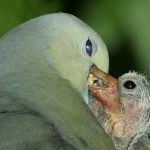 Whereas most humans regurgitate their food only when they are in gastroin-testinal distress (for example, as the result of stomach flu, salmonella, or a dinner of kahlua and pickled eggs), some animals vomit up their stomach contents in order to provide nourishment for their young. Pigeons do this, or at least they regurgitate the epithelial lining of their crop, which their chicks ingest by squeezing their heads far up into the throat of the adult. This substance, which resembles a fine-grain cottage cheese, has been known as pigeon’s milk since the late nineteenth century. The term did exist earlier on in English, however. In the late eighteenth century, pigeon’s milk denoted an imaginary item, the object of a fool’s errand. A pesky child might be sent to the dairy to procure some pigeon’s milk, much as I, at age seventeen on the first day of my new summer job, was told by my boss to stop by the carpentry department and pick up the shelfstretcher. Some animals also regurgitate their food, but not to feed their young. Cattle, for example, will return the food from their first stomach (they have four in total: the rumen, the reticulum, the omasum, and the abomasum), and rechew it before swallowing it again. This process is popularly known as chewing the cud, with the word cud dating back more than a thousand years in English. The more technical name for the same process is ruminate, derived from the name of the cow’s first stomach. Both of these—chew the cud and ruminate—have also developed the figurative sense of to ponder, due to the fact that a cud-chewing bovine appears to be deep in thought.
Whereas most humans regurgitate their food only when they are in gastroin-testinal distress (for example, as the result of stomach flu, salmonella, or a dinner of kahlua and pickled eggs), some animals vomit up their stomach contents in order to provide nourishment for their young. Pigeons do this, or at least they regurgitate the epithelial lining of their crop, which their chicks ingest by squeezing their heads far up into the throat of the adult. This substance, which resembles a fine-grain cottage cheese, has been known as pigeon’s milk since the late nineteenth century. The term did exist earlier on in English, however. In the late eighteenth century, pigeon’s milk denoted an imaginary item, the object of a fool’s errand. A pesky child might be sent to the dairy to procure some pigeon’s milk, much as I, at age seventeen on the first day of my new summer job, was told by my boss to stop by the carpentry department and pick up the shelfstretcher. Some animals also regurgitate their food, but not to feed their young. Cattle, for example, will return the food from their first stomach (they have four in total: the rumen, the reticulum, the omasum, and the abomasum), and rechew it before swallowing it again. This process is popularly known as chewing the cud, with the word cud dating back more than a thousand years in English. The more technical name for the same process is ruminate, derived from the name of the cow’s first stomach. Both of these—chew the cud and ruminate—have also developed the figurative sense of to ponder, due to the fact that a cud-chewing bovine appears to be deep in thought.
